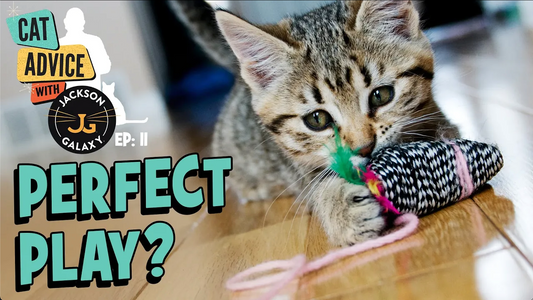A note about this series: Introducing cats to other animals can be a tricky affair. That said, it can also be smooth sailing, with very little potential conflict. And, it could fall somewhere between the two. Every animal is an individual, as is every human and every household. That’s exactly why I’ve made this series exhaustive in detail; I want to serve as many of those individuals as possible, and set everyone up for the best life possible.
Please don’t think that just because I’ve covered every angle, that means that cats are better left living on their own. I believe strongly that, by and large, cats should be with other cats. You may find that to serve the needs of both humans and non-humans in your home, you can move through some of these steps with ease. Great! And it’s equally fine if it takes awhile to get from beginning to end. Just remember: in the world of relationships, nothing is ever one-size-fits-all. It’s a process best served by being patient, empathetic, and mindful.
Now, let’s do this…with light, love and Mojo!
Episode Three: Dinner Time
In Episode One, we covered several initial steps to take before you bring your new cat home. In Episode Two, I introduced you to base camp, a concept that I’ve used through the years to ensure the smoothest initial transition for your new arrival into your home. Now, let’s kick things up a notch with the centerpiece of my protocol – a specific feeding ritual which will give us our best shot at the most harmonious, face-to-face introduction.

Step Three:
The “Other Side of the Door” Feeding Ritual
In the feline world of senses that are highly attuned to provide maximum territorial security, introducing the cats one sense at a time is the most nonthreatening way to do it – starting with their infamously sensitive sense of smell. This feeding ritual, which is all about creating a positive association between the newcomer and the resident cat, has evolved over the years, but by and large has always worked for me.
What’s involved? Very simply, mealtime will consist of bowls set up on either side of a closed door. These bowls should start out far enough apart so the cats will walk up, eat, and walk away without incident, but close enough that they sense there’s another cat on the other side of the door. From there, we gradually move the bowls closer.
Reminder: As discussed in Episode One, you should not be free-feeding! Structured meal time leading up to this ritual is imperative for this process to work effectively.
Here’s how it works:
1. Segregated Mealtime
- Set up dinner plates – one for the newcomer, one for the resident – at an equal and respectful distance from your “feeding door.”
- When choosing a door on either side of which they’ll feed, you always want to make sure that you have ample distance available on both sides of that door – realizing that, at first, your cats might not be comfortable with any less than a six-foot distance from the door.In other words, if you’re doing it at a doorway that leads down to your basement, and one of the cats has to eat on the stairs, that is probably not the best space. (Using the base camp door as your main feeding door is usually the best way to do it.)
- As for the “respectful distance,” that’s basically defined as the minimal distance each of the cats need to be from the door in order to walk up to the dish, eat, and walk away, without feeling the need to look around, run up to and bat the door, or swat, hiss, or engage in any other shenanigans that occur when cats are stressed out. This distance, at least initially, becomes the sweet spot at which each cat is aware of, but not threatened or distracted by, the other one.
Cat Daddy Tip: This technique is best accomplished with a human partner. That way, you have eyes on the proceedings from both sides of the door, the food can go down at the same time, and individual challenge lines can best be gauged. (Of course, if you are on your own, that’s no reason to throw in the towel! We are just talking perfect world here.)
When your cats are introduced to each other via this “remote handshake,” they smell food every time they meet. And the only time they smell food, they’re engaged in that handshake. This is what building positive associations is all about: other cat = food = good.
2. Work the Challenge Line
- Once you’ve identified that “safe” distance, it essentially becomes your cat’s Challenge Line. From there, every meal becomes a step of one paw over the line – by getting each plate incrementally closer to the door, and thus closing the distance between both diners,
the cats get increasingly comfortable with one another . . . all while they are enjoying their food. - If you’ve moved the bowls closer and you see that one or both cats stare at the door, start to flick or wag their tail, and show irritability, you are likely on the wrong side of the Challenge Line, and your cat will just decide that dinner is more trouble than it’s worth.
If this happens, move the food back and find that sweet spot again. (I recommend using painter’s tape to mark that spot on both sides of the door. Defining that Challenge Line visually is actually a great way of marking your cat’s progress, and yours.)
The goal is to get as close to that closed door as possible, with the same predictable result each time. Don’t move that Challenge Line until you get total compliance; there must be no shenanigans whatsoever. Once you’ve had two or three meals where there’s no response at all, it’s time to move the line closer. But, don’t get overzealous and move your line so much that someone freaks and sends you back to square one. Slow and steady definitely wins the race on this one.
Once you get to the point where the cats are eating every meal about a foot away from either side of the door and walking away without issue, then it’s time for the next phase and our next Episode: allowing visual access. See you then!
Even though this series might seem in depth, you ain’t seen nothing yet! There is actually much
more to be found in the chapter that this has been excerpted from in my new book, Total Cat Mojo.











